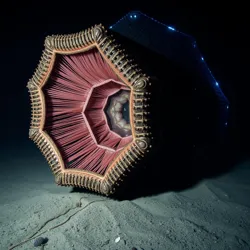Trencher's Maw
The Trencher's Maw (Megafiltrus hexagonalis) is a colossal filter-feeding organism inhabiting the deepest parts of the Midnight Trenches. First discovered in 2020, this remarkable creature has revolutionized our understanding of deep-sea filter feeding mechanisms and hadal zone ecology.
 The Trencher's Maw extending its feeding apparatus at 10,500 meters depth
The Trencher's Maw extending its feeding apparatus at 10,500 meters depthPhysical Characteristics
The most distinctive feature of the Trencher's Maw is its enormous hexagonal mouth structure, which can expand to over 100 meters in diameter when fully extended. The organism possesses a complex system of pressure-resistant filaments that form a sophisticated filtering network capable of processing vast quantities of sediment and water.
The creature's body consists of six primary segments that can contract or expand based on feeding conditions. Each segment contains specialized osmotic chambers that help regulate internal pressure at extreme depths. The organism's exterior is covered in bioluminescent nodules that produce a faint, pulsing blue light.
Behavior and Feeding
Trencher's Maw employs a unique feeding strategy called sediment cascade filtration, where it creates powerful currents to draw in both sediment and water. This process enables it to extract microscopic hadal organisms and organic matter with remarkable efficiency. The creature typically feeds for 72-96 hours before entering a dormant digestive phase.
Habitat and Distribution
These organisms are primarily found in the deepest oceanic trenches, particularly in areas with high sediment accumulation. They show a preference for regions near thermal nutrient upwellings, where they can access rich concentrations of organic matter.
Scientific Significance
The discovery of Trencher's Maw has led to several groundbreaking insights:
-
New understanding of deep-sea nutrient cycling
-
Evidence of complex filter feeding evolution at extreme depths
-
Discovery of previously unknown hadal microorganisms
Research Challenges
Studying the Trencher's Maw presents unique difficulties due to its extreme habitat depth and sensitive nature. The creature has shown vulnerability to disruption from traditional research methods, leading to the development of new non-invasive observation techniques.
See Also
- Abyssal Filter Feeders
- Deep Sea Current Dynamics
- Hexagonal Adaptation Theory
References
- Hadal Zone Quarterly
- Deep Sea Biology Review
- Journal of Extreme Ocean Life